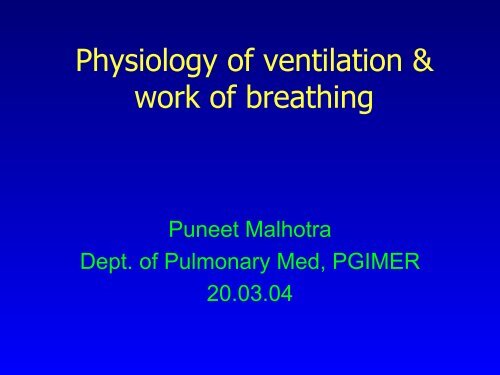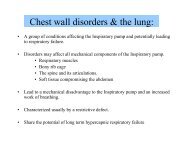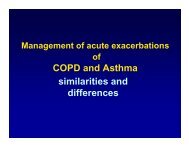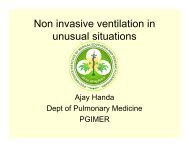Physiology of ventilation & work of breathin
Physiology of ventilation & work of breathin
Physiology of ventilation & work of breathin
Create successful ePaper yourself
Turn your PDF publications into a flip-book with our unique Google optimized e-Paper software.
<strong>Physiology</strong> <strong>of</strong> <strong>ventilation</strong> &<br />
<strong>work</strong> <strong>of</strong> <strong>breathin</strong>g<br />
Puneet Malhotra<br />
Dept. <strong>of</strong> Pulmonary Med, PGIMER<br />
20.03.04
Goals <strong>of</strong> respiration<br />
1.Ventilation<br />
2.Diffusion <strong>of</strong> O 2 & CO 2<br />
3.Transport <strong>of</strong> O 2 & CO 2<br />
4.Regulation <strong>of</strong> respiration
Ventilation<br />
• Movement <strong>of</strong> air in & out <strong>of</strong> lungs<br />
the airways<br />
respiratory muscles<br />
dead space <strong>ventilation</strong><br />
• Measurement <strong>of</strong> <strong>ventilation</strong><br />
• The <strong>work</strong> <strong>of</strong> <strong>breathin</strong>g<br />
• Importance in the ICU
Movement <strong>of</strong> air in & out <strong>of</strong> lungs<br />
The airways<br />
Anatomic dead space
quadriplegics<br />
COPD<br />
Respiratory Muscles<br />
Inspiration Expiration
Hoover’s sign<br />
The diaphragm
Effect <strong>of</strong> posture on respiratory muscles<br />
Upright: FRC<br />
Supine: FRC<br />
Lateral:
The pressures<br />
• Pressure differences > airflow<br />
•P pl precede P alv<br />
•P alv and air flow in phase<br />
• At points <strong>of</strong> no flow P alv = 0
• 3 types<br />
Dead space <strong>ventilation</strong><br />
• Anatomic dead space<br />
1ml/lb ideal body wt., 150 ml/500ml VT<br />
VT- anat dead space/VT ratio<br />
e.g.150/500=30%, 150/300=50%<br />
can gas exchange occur if pt. is<br />
ventilated with VT< anat dead space?
Yes:<br />
high freq<br />
<strong>ventilation</strong><br />
VA = f x [V T - V D]
• Alveolar dead space<br />
V/Q = Infinity<br />
PTE, Pulm vasoc, CO<br />
• Physiologic dead space (V D)<br />
anat + alveolar dead space<br />
Normally V D = anat dead space<br />
V D/V T = (P aCO 2-P ECO 2) / P aCO 2<br />
Measurement <strong>of</strong> ventilatory capacity<br />
• MIP, MEP<br />
• FVC (FEVC, FIVC)<br />
•FEV 1<br />
•PEFR<br />
• MBC/MVV<br />
depend on a<br />
single maneuver<br />
depends on continued<br />
maximal effort
Work <strong>of</strong> <strong>breathin</strong>g<br />
• Work to overcome “afterload” on resp system<br />
• Spont <strong>ventilation</strong>: resp muscles<br />
Controlled <strong>ventilation</strong>: ventilator<br />
Partial support: both<br />
• Work = Force x Distance<br />
= Pressure x Volume<br />
• SI unit = Joule/L
0.5L<br />
v<br />
Normally <strong>work</strong> is performed only for inspiration<br />
Divided into 2 fractions<br />
E<br />
5 10cm H2O TranspulmP I<br />
R el<br />
R aw
“minimal” <strong>work</strong> <strong>of</strong> <strong>breathin</strong>g<br />
Actual <strong>work</strong> performed by resp m. in health is minimal<br />
VO2R = 3ml/min (
Importance in the ICU<br />
• Measurement <strong>of</strong> WOB in ICU not routine<br />
• Until recently performed by physiologists>clinicians<br />
• Most ICU pts. are extubated < 96 hrs using standard<br />
weaning criteria<br />
• “advantages” <strong>of</strong> measuring WOB<br />
ensure pt.-vent synchrony<br />
aid to weaning<br />
comparison <strong>of</strong> diff. modes <strong>of</strong> MV
2 ways:<br />
Measurement <strong>of</strong> WOB in ICU<br />
a) Determination <strong>of</strong> O 2 cost <strong>of</strong> <strong>breathin</strong>g<br />
b) Measurement <strong>of</strong> mechanical WOB<br />
a) O 2 cost <strong>of</strong> <strong>breathin</strong>g<br />
Total VO 2 –VO 2 during spont <strong>breathin</strong>g<br />
[ VO 2 = CO X (CaO 2-CVO 2) ]<br />
drawbacks:<br />
in ICU O 2 COB may represent small % <strong>of</strong> VO 2<br />
VO 2 itself influenced by many other factors
) Measurement <strong>of</strong> mechanical WOB<br />
•2 ways<br />
a) Graphics<br />
P aw tracings<br />
P/V curves<br />
b) Pressure time product
P aw tracings
P/V curves<br />
Example 1
E<br />
P/V curves Example 2<br />
I<br />
Normal PV loop PV loop in COPD<br />
E<br />
I
Pt. effort to trigger<br />
ventilator<br />
Solution: increase<br />
trigger sensitivity<br />
P/V curves Example 3<br />
E<br />
I
Pressure time product
Pressure time product (contd.)<br />
• Work = P.dV<br />
• Underestimates isometric <strong>work</strong> i.e. resp m. <strong>work</strong><br />
which consumes O 2 but doesn’t result in dV e.g.<br />
against PEEPi<br />
• Under heavy loading conditions e.g. ARDS PTP<br />
correlates better with fatigue potential<br />
• Pressure time index = P/Pmax x Ti/Ttot<br />
>0.15 => fatigue
WOB measurement at the bedside<br />
• Bicore CP-100 Pulmonary Monitor<br />
• Automated measurement <strong>of</strong><br />
VA, Pulm mechanics<br />
WOBv and WOBp<br />
Respiratory drive<br />
• Oesophageal balloon, pnemotachograph







